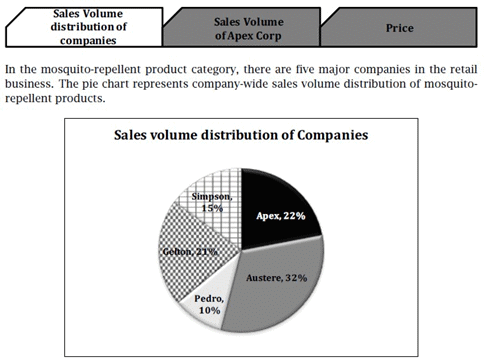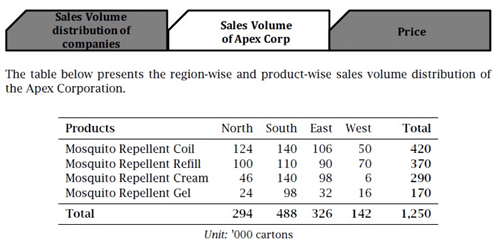Multi Source Reasoning Question Type
- As the name suggests, Multi-Source Reasoning (MSR) questions comprise information from more than one source. An MSR question will have two or three tabs of information; however, you can view only one tab at a time by clicking it. You are probably already familiar with this format as you encounter tabs in your daily use of internet browsers. The tabs contain a combination of written passages, graphs, diagrams, tables, or other types of visual information.
- A typical MSR dataset will have three questions; however, you will find three to six questions in Official Guide per dataset. You can find both multiple-choice questions and dichotomous-choice questions.
- For multiple-choice questions, five answer choices given. You have to select the correct answer choice. Alternatively, the dichotomous question presents three statements, values, or expressions. You may be asked whether, according to the information, each statement is True/False, Yes/No, Acceptable/Not Acceptable, Supported/Not Supported, or can be Inferable/Not Inferable.
- As with Table Analysis prompts, Multi-Source Reasoning prompts are dynamic, and you are expected to know how to effectively use the available interactivity.
Process of Solving MSR Questions
1. Understand the Data Set
- Briefly read over the information given in each tab. Understand it, but do not read it more than once at this stage.
- Then read the question. The nature of the MSR is that you will be given a lot of information relative to the amount of time you have. It is more time effective to read the questions as soon as you have a handle of the type of information you have and go back to read carefully once you know what you are looking for.
- Remember that only one question will be visible at a time. and you have on average 7.5 minutes to answer all three MSR questions.
2. Understand the Question
- Read the question and make sure you understand it.
- Remember that the strategy here is to only do one brief read of the dataset before going to the question, so be sure you understand what is being asked.
3. Develop an Approach
- You will have to gather information from more than one tab. For example, a question might ask about a company's profit. Suppose Tab 1 gives details about revenue and sales, whereas Tab 2 gives details about budget and cost. You must sift through both tabs to get the answer.
- With this in mind, although it is not suggested that you deeply read each tab, you do want to have a good general idea of what you can find in the different tabs to be able to go back and read carefully when needed. Consider taking notes if the table headers aren't enough information to jog your memory.
4. Apply the Approach
- Now that you have an idea of what each tab holds, read the question, and scan again for keywords, phrases, or figures to be able to answer the question as quickly as possible.
- Do your scratch work neatly, as you may need to use some calculations again to answer another question.
Example
Tab 1

Tab 2

Tab 3

Question 1:

Solution:
Part A: From Tab 1, you know that the percent sales volume for the Apex Corporation is 22% of the total sales volume of all five companies. From Tab 2, you know that the sales volume of the Apex Corporation is 1,250,000 cartons. So, 22% × (total sales)=1,250,000.
Again, from Tab 1, you will find that the percent difference of the sales volume of the Austere Corporation and the Pedro Corporation is 32−10=22%, which is equal to the percent sales volume of Apex. Hence, the answer is exactly 1,250,000, not more.
The correct answer is "No."
Part B: In a nutshell, you are asked to find out for Apex Corporation whether
Revenue from the Eastern region > Revenue from the Northern region
This question may appear to be time-consuming, but the GMAT never asks a question that is too time-consuming. So, there must be an alternate approach.
We find that the sales volumes of Coil and Refill products are more for the Northern region than for the Eastern region, while the opposite is true for Cream and Gel products. You must analyze which mosquito repellent(s) will contribute more in revenue to a region when sales volumes are multiplied with their respective prices. Clearly, the impact of the Cream product is very high, as the Eastern region sells 98,000−46,000=52,000 more mosquito repellent Cream than does the Northern region. Also, its price ($150 per carton) is second highest among all the products. This is going to contribute more in revenue to the Eastern region compared to the Northern region. Though Northern region sells 100,000−90,000=10,000 more units of the highest priced ($195 per carton) mosquito repellent Refill, its impact is relatively low as 10,000≪52,000. Similarly, though Northern region sells 124,000−106,000=18,000 more units of low priced ($95 per carton) mosquito repellent Coil, its impact is relatively low. So collectively, we find that (10,000+24,000=34,000)≪52,000. So, the answer would be "Yes." In fact, the Eastern-region revenue is more than Northern-region's by $4,760,000.
The correct answer is "Yes."
The table below presents the computation.

Part C: Fetching the data from Tabs 2 and 3, you will find that the carton price of the Refill ($195 per carton) is almost double that of the Coil ($95 per carton), while sales volume of the Refill is a mere ≈10% less than that of the Coil. Collectively, the revenue from the Refill sales would be more than that from the Coil sales.
The correct answer is "No."
Question 2: Keeping the total sales volume the same for the Apex Corporation, which of the following rearrangement of sales volume of products will generate more sales revenue than currently?
(A) Reduce the Mosquito Coil sales volume by half and increase the sales volume of Mosquito Repellent Gel by the same amount.
(B) Reduce the Mosquito Refill sales volume by one-third and increase the sales volume of Mosquito Repellent Cream by the same amount.
(C) Reduce the Mosquito Cream sales volume by 20% and increase the sales volume of Mosquito Repellent Gel by the same amount.
(D) Reduce the Mosquito Coil sales volume by 33.33% and increase the sales volume of Mosquito Repellent Cream by the same amount.
(E) Reduce the Mosquito Repellent Cream sales volume by 66.66% and increase the sales volume of Mosquito Coil by the same amount.
Solution: In all the options, the sales volume of one kind of mosquito repellents is reduced and that of another kind is increased by the same amount. So, the revenue can be increased if a product with a lower price is replaced by a product with a higher price. In one instance, reduced sales volume of the Coil ($95 per carton) is offset by the relatively high-priced Mosquito Cream ($155 per carton). This move will certainly increase the revenue. For the other options, the revenue will decrease. The correct answer is option D.


























